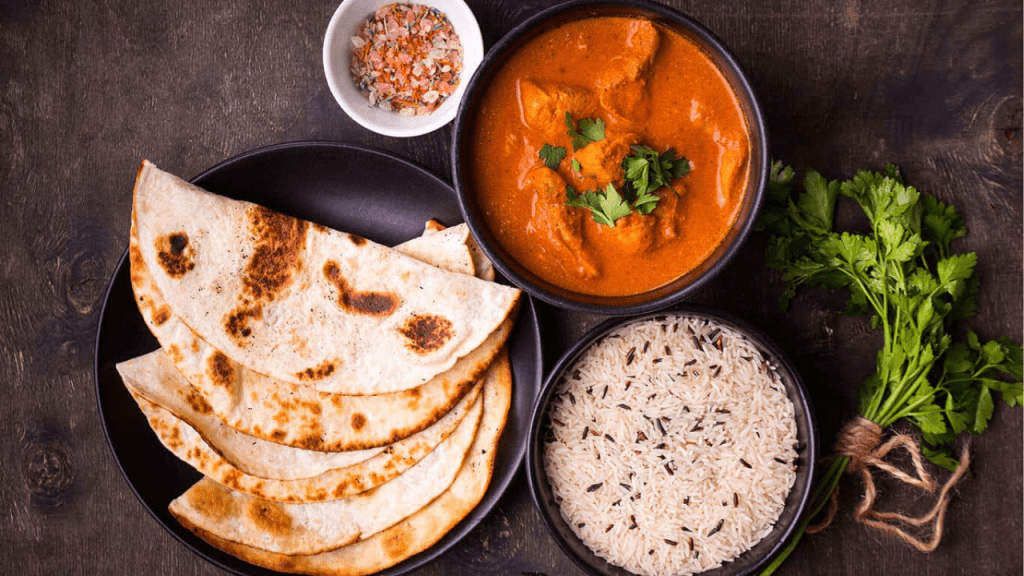Indian cuisine is globally celebrated for its vibrant spices, rich gravies, and deep-rooted culinary traditions. However, many of the most beloved Indian dishes—such as butter chicken, naan, and biryani—can be high in calories, fats, and refined ingredients. The good news is that with a few mindful adjustments, you can still enjoy the flavors you love in a much healthier way.
In this blog, we’ll explore nutritious alternatives and healthy cooking techniques to create healthy versions of popular Indian food that don’t compromise on taste.
In this Article
1. Butter Chicken Reimagined: Grilled Chicken in Yogurt-Tomato Sauce
Butter chicken is a creamy delight, but it’s often made with generous amounts of butter and cream. To make it healthier:
- Use boneless, skinless chicken grilled or air-fried to reduce fat.
- Replace heavy cream with low-fat Greek yogurt, which maintains creaminess while cutting calories.
- Cook with heart-healthy olive oil instead of butter.
The marinade plays a key role in retaining flavor. Marinate the chicken in yogurt, lemon juice, and spices for at least two hours to ensure it stays tender and flavorful.
2. Paneer Tikka Masala Made Lighter: Tofu Tikka in Cashew Sauce
Tofu Tikka Masala – A Vegan Twist on a Classic Indian Favorite
Paneer tikka masala is rich and indulgent but often loaded with saturated fats.
- Substitute paneer with firm tofu, which has less fat and more plant-based protein.
- Use blended cashew paste for a creamy texture instead of cream.
- Bake or air-fry tofu instead of shallow frying.
To retain the smoky, earthy flavor, add smoked paprika or char the tofu slightly on a skillet before mixing with the sauce.
3. A Whole-Grain Twist: Brown Rice Vegetable Biryani
Biryani is a festive favorite but can be carb-heavy with white basmati rice and generous use of oil.
- Opt for brown rice, which adds fiber and nutrients.
- Incorporate a variety of vegetables like carrots, beans, peas, and bell peppers.
- Replace ghee with avocado or light olive oil to lower saturated fat.
Using low-fat saffron-infused almond milk instead of yogurt or cream can help retain the signature aroma and richness of traditional biryani without the extra calories.
4. A Healthier Naan: Whole Wheat Garlic Naan Without Butter
Naan is typically made with refined flour and slathered with butter. You can create a healthier version by:
- Using whole wheat flour instead of maida (all-purpose flour).
- Skipping butter and using garlic-infused olive oil for flavor.
- Cooking the naan on a cast iron skillet rather than in a tandoor with added fats.
Adding herbs like cilantro and nigella seeds boosts both flavor and nutrition.
5. Dal Makhani Gets a Makeover: Mixed Lentils in Coconut Milk
Dal Makhani: A Creamy Delight from Punjab
Dal Makhani is a comforting staple but often contains butter, cream, and whole milk.
- Use a mix of masoor, moong, and toor dal to add protein and fiber.
- Replace heavy dairy cream with light coconut milk or unsweetened almond milk.
- Use minimal oil and focus on slow cooking to develop flavor naturally.
Adding ginger, garlic, and roasted cumin enhances depth without needing extra fat.
6. Refreshing and Nutritious Raita: Cucumber Mint Yogurt with Flax Seeds
Raita is often used as a cooling side, but it can be made even healthier:
- Use low-fat Greek yogurt for extra protein and creaminess.
- Add grated cucumber, mint leaves, and roasted cumin powder for digestive benefits.
- Top with ground flax seeds for a boost of omega-3 fatty acids and fiber.
Chilling the raita for 30 minutes before serving helps enhance the flavors and makes it a perfect side to spicy dishes.
Why Healthy Versions of Indian Food Work
The beauty of Indian cuisine lies in its use of spices, herbs, and slow-cooking methods—all of which are naturally healthy. By replacing refined ingredients and cooking with mindful techniques, you preserve the soul of the dish while making it suitable for modern dietary needs. These healthier versions are great for:
- Individuals managing weight
- People with dietary restrictions
- Families looking for nutritious home-cooked meals
With small changes, such as switching from refined oils to cold-pressed ones or using low-fat dairy substitutes, Indian food can be both healthy and satisfying.
You don’t have to give up your favorite meals in the name of health. These healthy versions of popular Indian food allow you to enjoy traditional flavors while staying on track with your wellness goals. Whether you’re preparing a weekday dinner or a festive spread, these alternatives are proof that delicious and nutritious can go hand in hand.
If you’re looking to further optimize your Indian food habits, consider exploring low-carb Indian meals, plant-based alternatives, and air-fryer recipes in our upcoming blogs.
